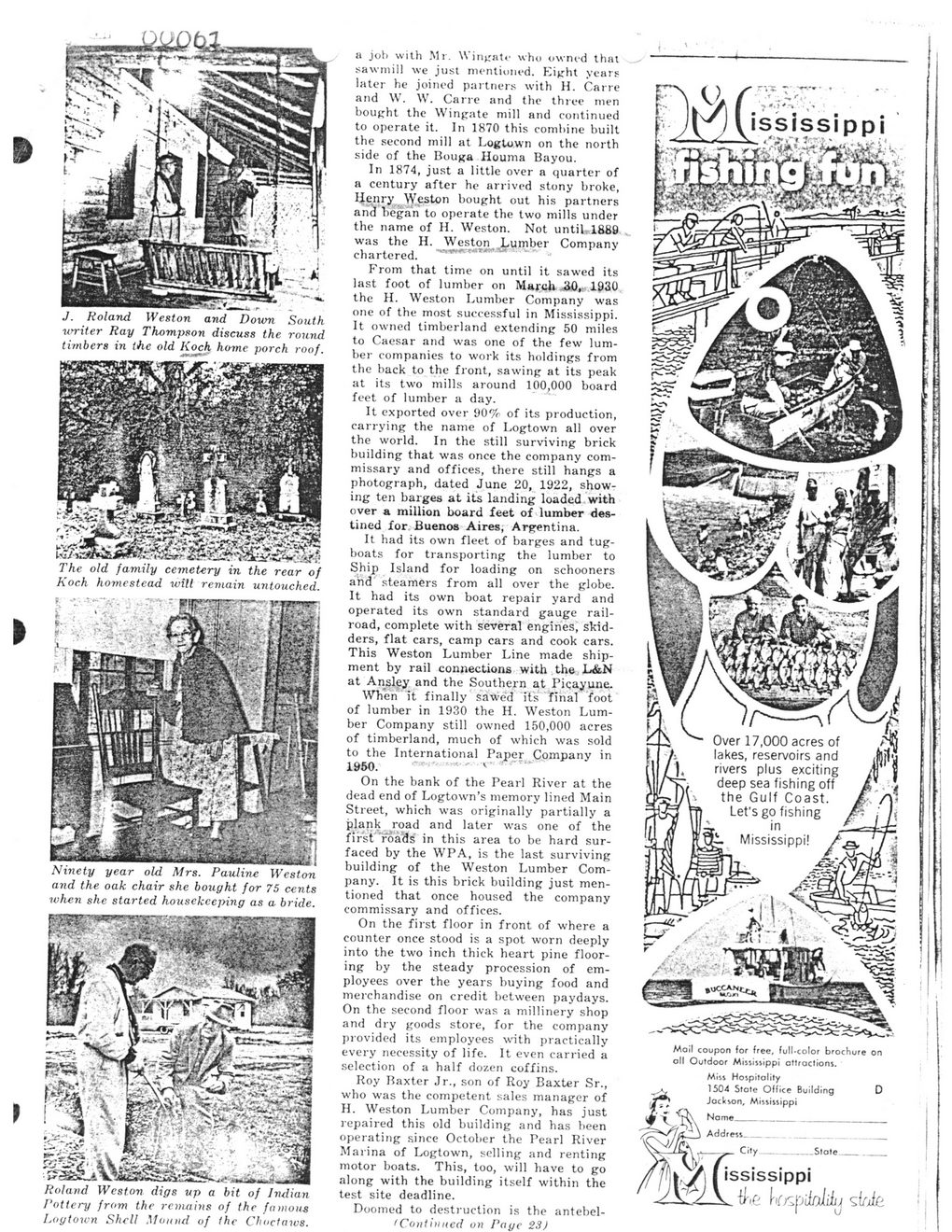This text was obtained via automated optical character recognition.
It has not been edited and may therefore contain several errors.
UUObl J. Roland Weston and Down South urriter Ray Thompson discuss the round timbers in the old Koch home porch roof. The old family cemetery in the rear of Koch homestead will remain untouched. Ninety year old Mrs. Pauline Weston and the oak chair she bought for 75 cents when she started housekeeping as a bride. Roland Weston digs up a bit of Indian Pottery from the remains of the famous Log town Shell Mound of the Choctaws. a job with Mi. Wingatr who owned that sawmill we just mentioned. Eight year? later he joined partners with H. Carre and \V. \V. Carre and the three men bought the Wingate mill and continued to operate it. In 1870 this combine built the second mill at Logtown on the north side of the Bouga Houma Bayou. In 1874, just a little over a quarter of a century after he arrived stony broke, Henry Weston bought out his partners and liegan to operate the two mills under the name of H. Weston. Not until 1889 was the H. Weston Lumber Company chartered. From that time on until it sawed its last foot of lumber on March ..30, 1930 the H. Weston Lumber Company was one of the most successful in Mississippi. It owned timberland extending 50 miles to Caesar and was one of the few lumber companies to work its holdings from the back to the front, sawing at its peak at its two mills around 100,000 board feet of lumber a day. It exported over 90% of its production, carrying the name of Logtown all over the world. In the still surviving brick building that was once the company commissary and offices, there still hangs a photograph, dated June 20, 1922, showing ten barges at its landing loaded with over a million board feet of lumber destined for Buenos Aires, Argentina. It had its own fleet of barges and tugboats for transporting the lumber to Ship Island for loading on schooners and steamers from all over the globe. It had its own boat repair yard and operated its own standard gauge railroad, complete with several engines, skid-ders, flat cars, camp cars and cook cars. This Weston Lumber Line made shipment by rail connections with the L&N at Ansley and the Southern at Piqayune. When it finally sawed its final foot of lumber in 1930 the H. Weston Lumber Company still owned 150,000 acres of timberland, much of which was sold to the International Paper Company in 1950. ' On the bank of the Pearl River at the dead end of Logtown’s memory lined Main Street, which was originally partially a plank road and later was one of the first roads in this area to be hard surfaced by the WPA, is the last surviving building of the Weston Lumber Company. It is this brick building just mentioned that once housed the company commissary and offices. On the first floor in front of where a counter once stood is a spot worn deeply into the two inch thick heart pine flooring by the steady procession of employees over the years buying food and merchandise on credit between paydays. On the second floor was a millinery shop and dry goods store, for the company provided its employees with practically every necessity of life. It even carried a selection of a half dozen coffins. Roy Baxter Jr., son of Roy Baxter Sr., who was the competent sales manager of H. Weston Lumber Company, has just repaired this old building and has been operating since October the Pearl River Marina of Logtown, selling and renting motor boats. This, too, will have to go along with the building itself within the test site deadline. Doomed to destruction is the antebel-f Continued on Page 23J OMiHsippi m Mail coupon for free, full-color brochure on all Outdoor Mississippi attractions. Miss Hospitality 1504 Stote Office Building D Jackson, Mississippi Stote ississippi c kjzpdaliiij strJa

Gainesville Five-Coast-Communities-with-Less-Than-Three-Years-to-Live-2